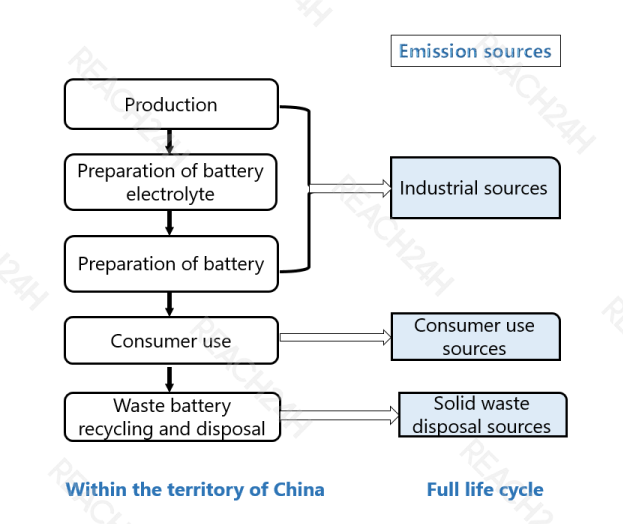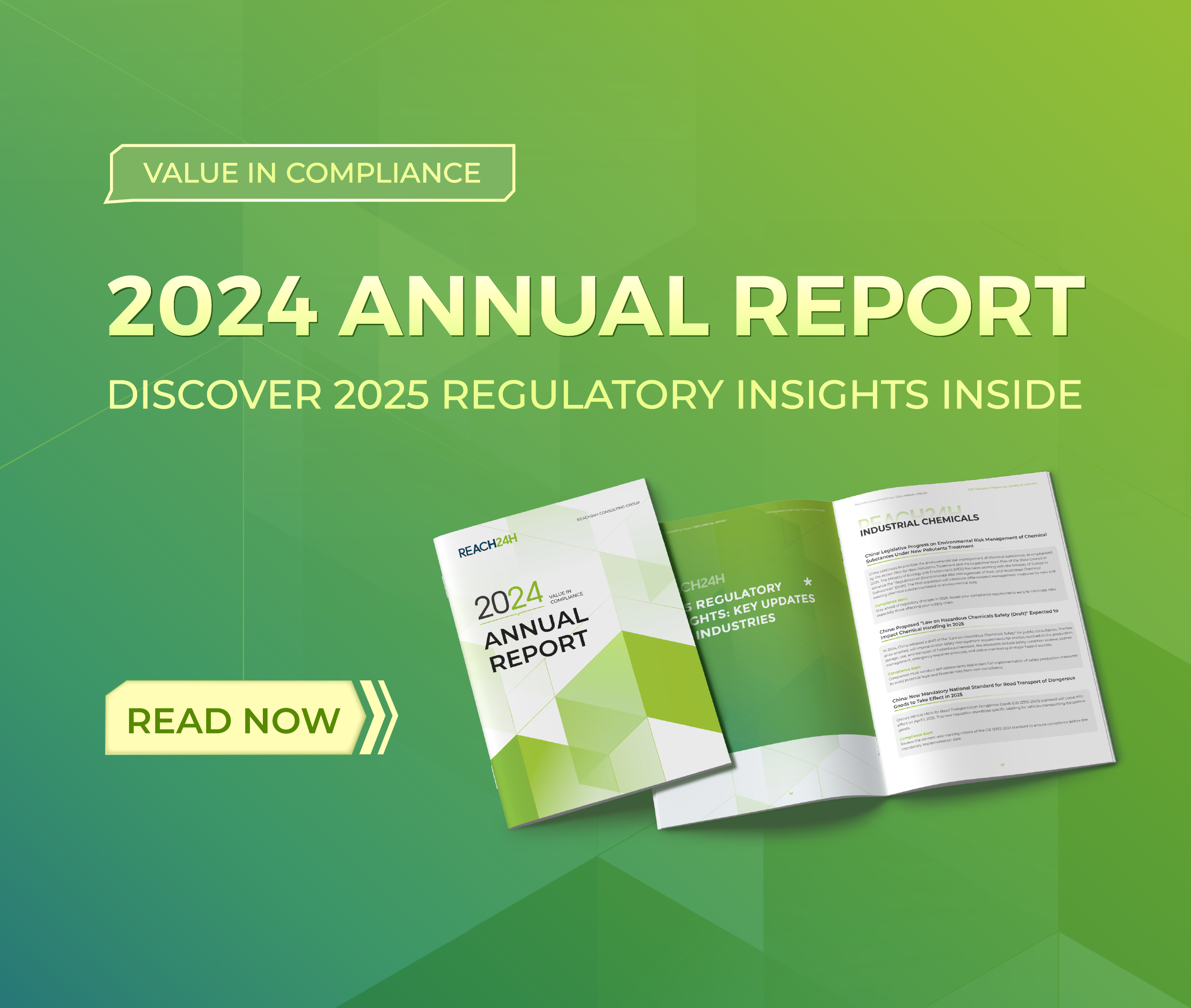China’s New Chemical Registration: Environmental Risk Assessment and Exposure Scenario Guidelines
“The Measures for the Environmental Management Registration of New Chemical Substances” (MEE Order No. 12) has been implemented since January 1, 2021. The environmental risk assessment report is the focus of technical review in the process of regular registration, but there are many challenges in the preparation of the report. REACH24H has assisted hundreds of enterprises in completing the simplified and regular registration under the MEE Order No.12 and has also accumulated rich experience in the preparation of environmental risk assessment reports. Later, we will share with you the key points and practical guidelines for environmental risk assessment in the process of regular registration of new chemical substances. This article will focus on the preparation requirements in the preparation of environmental risk assessment reports and the construction of exposure scenarios.
I. Principles for Environmental Risk Assessment Report Preparation
Principle 1: The preparation of environmental risk assessment reports shall follow the principles of “scientific basis, respect for facts, sufficient argumentation, standardized expression, and conservative assessment”.
Principle 2: The preparation of environmental risk assessment reports shall be carried out in accordance with the relevant technical guidelines issued by the competent Department of Ecology and Environment under the State Council or the relevant internationally accepted technical documents. The relevant technical guidelines include: “Guidelines for Registration of Environmental Management of New Chemical Substances”, “Technical Guidelines for Environmental and Health Hazard Assessment of Chemical Substances (Trial)”, “Technical Guidelines for Environmental and Health Exposure Assessment of Chemical Substances (Trial)”, “Technical Guidelines for Environmental and Health Risk Characterization of Chemical Substances (Trial)” and “Specifications for Classification and Labelling of Chemicals – Part 18-29” (GB 30000.18~GB 30000.29), etc.
Principle 3: The preparation of environmental risk assessment reports shall scientifically assess the entry of chemical substances into the ecological environment and human exposure through the environment during the whole life cycle of production, processing and use, consumption and use, and waste utilization and disposal in China.
Principle 4: The preparation of environmental risk assessment reports shall be subject to credit management, and the preparation unit shall bear corresponding responsibilities for the environmental risk assessment reports it prepares.
II. Key Components of Environmental Risk Assessment Reports
The key points of environmental risk assessment report mainly include hazard assessment, exposure assessment and risk characterization of chemical substances. Hazard assessment includes environmental/health hazard identification and environmental/health hazard characterization. Exposure assessment includes the construction of exposure scenarios, the selection of exposure routes, the determination of emission sources and emission scenarios, the selection of exposure parameters, the use of exposure models, and exposure assessment. Risk characterization includes environmental risk characterization, health risk characterization, and uncertainty analysis. See the table below:
| Assessment content | Assessment points | |
| Hazard assessment | Environmental hazard identification | The process of identifying and determining the types and properties of chemical substances that can have adverse effects on environmental biological individuals and (sub)populations. |
| Health hazard identification | The process of identifying and determining the types and properties of chemical substances that can have adverse effects on the human body. | |
| Environmental hazard assessment | The process of determining the potential hazards to environmental biological individuals and (sub)populations when exposed to chemical substances. It includes environmental hazard identification and environmental hazard characterization. | |
| Health hazard assessment | The process of determining the potential health hazards to the human body when exposed to chemical substances through environmental media. It includes health hazard identification and health hazard characterization. | |
| Exposure assessment | Exposure scenario | A set of facts, assumptions, and assumptions about emission sources and emission scenarios, exposure routes, exposure parameters, exposure models, and exposure receptors that are used to assist in assessing and quantifying receptor exposure under given conditions. |
| Exposure route | Environmental exposure route refers to the route by which chemical substances reach environmental receptors after discharge, and health exposure route refers to the way in which chemical substances enter the human body after contact with the human body (such as ingestion, inhalation, and percutaneous). | |
| Emission source | Sources of chemical discharges to the environment, including industrial sources, consumer use sources, solid waste utilization and disposal sources, and centralized sewage treatment plants (STPs). | |
| Emission scenario | The environmental discharge of chemical substances at a specific life cycle stage or for a specific use, including the operating conditions and emission reduction measures involved in production and use, etc., used to estimate the environmental discharge rate of chemical substances at a specific life cycle stage or for a specific use. | |
| Exposure assessment | Determine the emission scenarios and exposure routes of chemical substances, and estimate and measure the exposure level (concentration or dose) of environmental organisms and the human body. | |
| Exposure model | The exposure model describes the exposure process of receptors to chemical substances, and estimates the conceptual model and mathematical simulation method of exposure concentration and exposure amount. | |
| Exposure parameter | Parameters used to describe the exposure characteristics and behavior of the environment and the human body. | |
| Risk characterization | Environmental risk characterization | Based on the environmental hazard assessment and exposure assessment of chemical substances, analyze and determine the degree of risk of chemical substances to the ecological environment, which is usually expressed by the environmental risk characterization ratio. |
| Health risk characterization | Based on the health hazard assessment and exposure assessment of chemical substances, analyze and determine the degree of risk of chemical substances to human health through environmental exposure, which is usually expressed by the health risk characterization ratio. | |
| Uncertainty | Due to insufficient scientific understanding, limitations of assessment methods, and lack of basic data, etc., the degree of deviation of the environmental and health risk assessment results of chemical substances from the actual situation. | |
Note: The above definitions are from “Technical Guidelines for Environmental and Health Hazard Assessment of Chemical Substances (Trial)”, “Technical Guidelines for Environmental and Health Exposure Assessment of Chemical Substances (Trial)”, “Technical Guidelines for Environmental and Health Risk Characterization of Chemical Substances (Trial)”.
III. Developing Exposure Scenarios
In the process of regular registration of new chemical substances, the construction of exposure scenarios is one of the most important parts of environmental risk assessment. Even in the early stage of scheme preparation, the specific conditions of exposure scenarios during the actual production/use of new chemical substances should be considered. For example, if the main exposure route of a new chemical substance is inhalation, the repeated inhalation toxicity test should be prioritized when arranging the testing. A complete and scientific exposure scenario can reflect the specific situation of how chemical substances are exposed to the human body or the ecosystem in the environment, so as to better assess the potential risks of chemical substances to human health and the ecological environment.
- Key steps in constructing exposure scenarios
Emission source identification: Identify all possible emission sources of chemical substances, including industrial sources, consumer use sources, and solid waste disposal sources.
Exposure route determination: Clarify the transmission routes of chemical substances from emission sources to receptors (human body or ecosystem), such as inhalation, ingestion, skin contact, etc.
Environmental conditions consideration: Include factors such as climate, soil type, hydrological conditions, etc., which can affect the transmission and fate of chemical substances.
- Principles for Constructing Exposure Scenarios
Reasonable worst-case assumptions: Select a relatively harsh condition in reality as the assessment benchmark to ensure that the needs of environmental protection can be met under other conditions.
Consideration of realistic conditions: As close to the actual situation as possible, considering differences in geographical location, meteorology, etc.
- Spatial and temporal scales of exposure scenarios
Spatial scale: Exposure assessment can be conducted at point source scale or regional scale, considering the concentration of chemical substances in different environmental media.
Temporal scale: Consider the duration and frequency of exposure to assess the effects of long-term or short-term exposure.
- Uncertainty management in exposure scenario construction
Uncertainty identification: Clarify possible uncertainties in scenario construction, such as data gaps or model assumptions.
Uncertainty handling: Manage uncertainty by collecting more data, using conservative assumptions, or conducting sensitivity analyses.
By paying attention to these considerations, the construction of exposure scenarios can be ensured to be scientific, reasonable, and effectively support environmental risk assessment.
IV. Case Study: Exposure Scenario Development
Taking the exposure scenario of battery electrolyte as an example, the construction process of its exposure scenario is shared.
A company produces a new substance (organic), which is sold to domestic downstream customers for the preparation of battery electrode liquid, and then used to prepare batteries. The batteries are applied in digital products, household appliances, etc. After use, consumers discard them into municipal trash bins (toxic waste), which are collected by municipal sanitation fleets and then transported to municipal waste treatment plants for recycling and disposal.
All the above processes occur within China. According to the principle of the full life cycle, the substance involves a total of 5 exposure scenarios: the production process, the preparation process of the battery electrolyte, the preparation process of the battery, the consumer use process, and the waste battery recycling and disposal scenario. Among them, the first three scenarios are industrial sources, the consumer use process is a consumer use source, and the waste battery recycling and disposal is a solid waste disposal source, as shown in the figure below:

The process under the production scenario is known to the enterprise, and complete information is available for the calculation of exposure assessment. The preparation of battery electrolyte and the preparation of batteries involve downstream and even further downstream customers, and the applicant may not have access to complete information. In such cases, reference should be made to industry practices for analysis, and a relatively harsh condition in reality should be selected as the assessment benchmark to ensure that the needs of environmental protection can be met under other conditions. The process of consumers using batteries mainly involves installing the batteries into digital products and household appliances, and since the new substance is encapsulated within the battery and does not have the characteristics of dispersed discharge, it will not be released into the environment. Therefore, there is no need to calculate the process of the applied substance being discharged into the environment through consumer use sources. The waste battery recycling and disposal process is generally carried out by units with relevant industry qualifications and technical capabilities, who recycle the batteries and recover the metals in the electrolyte materials before performing high-temperature pyrolysis treatment. After treatment, the organic part of the substance is decomposed at high temperature, thus completing the full life cycle assessment of the new substance.
Conclusion
The preparation of environmental risk assessment reports is one of the difficulties in the environmental management registration of new chemical substances. In the process of constructing exposure scenarios, it is necessary to identify emission sources, determine exposure routes, and consider environmental conditions. Combined with the temporal and spatial scales in the exposure process, under reasonable worst-case assumptions and consideration of realistic conditions, constructing scientific and reasonable exposure scenarios can more effectively support the assessment of environmental risks.
REACH24H will continue to share with you the key points and practical guidelines for environmental risk assessment in the registration of new chemical substances based on its own registration experience. Stay tuned~
Contact us to learn how we can assist you with China REACH compliance and market access!
Reference:


